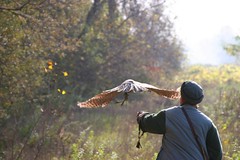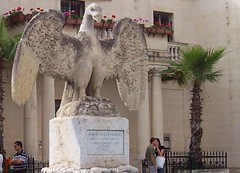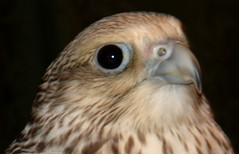The world is a mask that hides the real world.
Thatâs what everybody suspects, though the world we see wonât let us dwell on it long.
The world has ways - more masks - of getting our attention.
The suspicion sneaks in now and again, between the cracks of everyday existenceâ¦the bird song dips, rises, dips, trails off into blue sky silence before the note that would reveal the shape of a melody that, somehow, would tie everything together, on the verge of unmasking the hidden armature that frames this sky, this tree, this bird, this quivering green leaf, jewels in a crown.â¦
As the song dies, the secret withdraws.
The tree is a mask.
The sky is a mask.
The quivering green leaf is a mask.
The song is a mask.
The singing bird is a mask.
Saturday, November 26, 2005
prey turns on hunter in bloody last-gasp attack

Bear shot by hunter bites back, dies
HARRISBURG, Pennsylvania (AP) -- A black bear bit and clawed a hunter who had just shot it four times in what game authorities said appeared to be a first for the state.
Samuel H. Beauchamp, 47, said he was approaching the downed 320-pound bear in Rothrock State Forest in central Pennsylvania on Monday, the first day of bear-hunting season, when it came after him.
Beauchamp, of nearby Newville, had just shot the bear with a .444-caliber rifle and was within 15 feet of it. He turned to run, but the bear put a claw around his hip and bit him twice, once in each thigh, before dying.
"The bear wasn't attacking 100 percent. I mean really, it was dead on its feet when it came up. If it would have been 100 percent I wouldn't have been standing there," Beauchamp said Friday.
Other hunters heard a growl and came to Beauchamp's aid.
"It was shock at first. It's like he came alive, like 'boom.' I guess he growled, like the other people heard. That motivated me to turn around and start running away," he said.
Game commission bear biologist Mark Ternent said the attack was the first case known to state officials in which a bear had attacked a hunter who had just shot it and was attempting to recover it.
Beauchamp was released from the hospital after about two hours of treatment. One bite went down to the bone.
"I didn't feel any pain after it happened," he said Friday. "I'm a little sore now."
Copyright 2005 The Associated Press. All rights reserved.
Find this article at:
http://www.cnn.com/2005/US/11/25/bear.attack.ap/index.html
Friday, November 25, 2005
Swimming with dolphins can alleviate depression

24-Nov-2005
Contact: Emma Dickinson
edickinson@bmj.com
44-20-7383-6529
BMJ-British Medical Journal
Swimming with dolphins can alleviate depression
Randomised controlled study of animal facilitated therapy with dolphins in the treatment of depression BMJ Volume 331, pp 1231-4
Swimming with dolphins is an effective treatment for mild to moderate depression, say researchers in this week's BMJ.
Their findings support the theory of biophilia, which shows how human health and wellbeing are dependent on our relationships with the natural environment.
The study was carried out in Honduras and involved 30 patients diagnosed with mild or moderate depression. Half were assigned to the experimental group and half to the control group.
Over a two-week period, participants in the experimental group swam and snorkelled in the water with dolphins for one hour a day. Participants in the control group were assigned to the same water activities, but in the absence of dolphins, to control for the influence of water and the natural setting.
All participants discontinued antidepressant drugs or psychotherapy at least four weeks before entering the study, and were not allowed to take drugs during the study. Depression scores were measured before the study and at the end of treatment.
Although some participants dropped out of the study, the average severity of the depressive symptoms was more reduced in the experimental group than in the control group.
Animal facilitated therapy with dolphins is more effective than water therapy in treating people with mild to moderate depression, say the authors. Despite some study limitations, the effects exerted by the animals were significantly greater than those of just the natural setting.
The echolocation system, the aesthetic value, and the emotions raised by the interaction with dolphins may explain the mammals' healing properties, they suggest.
Three months after the study, participants in both groups also reported lasting improvement and did not require treatment. This suggests that in patients with mild or moderate depression, using drugs or conventional psychotherapy may not be necessary when biophilic treatment with animals is used, they conclude.
eagloid
Thursday, November 24, 2005
Riverwalk(2): American Kestrel
I took a walk down on the San Pedro river for my birthday, with camera gear in tow.
This guy was sitting on top of a mesquite tree, scoping out the area. He let me get quite close. This is an extreme crop, about 1/4 of the total frame.
Nikon D100 using a Nikon AF VR Nikkor 80-400mm 1:4.5-5.6D lens at 400mm, f6.3, 1/2500s, ISO 400, pattern metering, normal program, auto exposure.
Wednesday, November 23, 2005
a new Buddah?

Meditating Nepal teen's fans think he's Buddha
Followers say Ram Bahadur Banjan hasn't had food or drink since May 17
The Associated Press Updated: 3:20 p.m. ET Nov. 23, 2005
KATMANDU, Nepal - A teenage boy has been meditating in a Nepalese jungle for six months, and thousands have flocked to see him, with some believing he is the reincarnation of Buddha, police and media said Wednesday.
Ram Bahadur Banjan, 15, sits cross-legged and motionless with eyes closed among the roots of a tree in the jungle of Bara, about 100 miles south of the capital, Katmandu.
He’s supposedly been that way since May 17 — but his followers have been keeping him from public view at night.
A reporter for the Kantipur newspaper, Sujit Mahat, said he spent two days at the site, and that about 10,000 people are believed to visit daily.
Soldiers have been posted in the area for crowd control, officials said.
A makeshift parking lot and cluster of food stalls have sprung up near Banjan’s retreat, an area not previously frequented by visitors.
Many visitors believe Banjan is a reincarnation of Gautama Siddhartha, who was born not far away in southwestern Nepal around 500 B.C. and later became revered as the Buddha, which means Enlightened One.
Others aren’t so sure.
Police inspector Chitra Bahadur Gurung said officers have interviewed the boy’s associates about their claim that Banjan has gone six months without food or drink.
Officers have not directly questioned the boy, who appears deep in meditation and doesn’t speak.
“We have a team ... investigating the claim on how anyone can survive for so long without food and water,” Gurung said.
Local officials have also asked the Royal Nepal Academy of Science and Technology in Katmandu to send scientists to examine Banjan.
Mahat said visitors can catch a glimpse of Banjan from a roped-off area about 80 feet away from him between dawn and dusk.
Followers then place a screen in front of him, blocking the view and making it impossible to know what he is doing at night, Mahat said.
“We could not say what happens after dark,” Mahat said. “People only saw what went on in the day, and many believed he was some kind of god.”
Buddhism teaches that right thinking and self-control can enable people to achieve nirvana — a divine state of peace and release from desire. Buddhism has about 325 million followers, mostly in Asia.
© 2005 The Associated Press. All rights reserved. This material may not be published, broadcast, rewritten or redistributed. © 2005 MSNBC.com
URL: http://www.msnbc.msn.com/id/10179215
photo: AP
BBC listens in to insect chatter
Caterpillars of large blue butterflies have been shown to communicate with ants, making noises that fool them into caring for the larvae as if their own.
And scientists are now looking into the idea that these sounds are actually overheard by the wasps that seek out such caterpillars to lay eggs in them.
It is one of many amazing tales to be found in TV's Life in the Undergrowth.
The new BBC natural history series from Sir David Attenborough starts on Wednesday.
It shows invertebrate activity never before caught on television cameras.
"In the past, in order to get close to something, you had to pour light on it; so much so you were at risk of frying the thing - and you certainly inhibited natural behaviour," Sir David said.
"We've now got such sensitive electronic cameras that we don't need that amount of light, and we've also got tiny, tiny lenses; so we can get up close and tight, and thn you see mind-blowing things."
Seek and destroy
The alcon blue butterfly ( Maculinea alcon ) of central Europe has long been recognised as a great con artist.
Its caterpillar emits sounds and a chemical signal which essentially "instructs" worker ants to pick it up and carry it back to their nest, where it is fed, cleaned and cared for as if it were one of the queen ant's own brood.
The caterpillar can live for up to two years inside the nest before pupating into a chrysalis, from which a new butterfly emerges.
It has an enemy, however: a parasitic wasp ( Ichneumon eumerus ). Unlike the ants, the wasp seems to know an impostor is present and, in what appears like a kamikaze manoeuvre, will enter the nest to find the caterpillar.
Jeremy Thomas, from the Centre for Ecology and Hydrology (CEH) in Dorset, UK, has been studying large blue butterflies for over 30 years and recently discovered how this wasp avoids death by releasing a chemical signal, or pheromone, of its own.
This not only repels the ants but causes them to attack one another. In the midst of this confusion the wasp seeks out the caterpillar and injects an egg deep inside its body.
When the wasp leaves the nest everything returns to normal and the caterpillar is once again fed and cleaned by the ants. But, when it turns into a chrysalis, it is eaten from the inside by the injected wasp grub - and it is the wasp that emerges to fly from the nest, not another alcon blue butterfly.
The right tune
Photographing all of this for TV is a first; but the great breakthrough for the scientists has been in getting clear recordings of the noises made by the blue caterpillars.
What is more, the CEH team has been able to show just what a direct effect these sounds have on the ants.
"We can get clean sounds and, using miniature equipment, we can get the caterpillars and ants behaving much more naturally than in the past," Dr Thomas told the BBC News website.
"Also, we can now play the sounds back to the ants, and that shows the sounds of the caterpillar match the ant it lives with much more closely than anyone thought previously.
"The ants react to the sounds in a positive way. They go to the microphones and tap them with their antennae."
But what of the wasp? The emerging hypothesis is that it hears these sounds, too. And although the ants may be fooled into thinking the caterpillar is one of their own, the wasp is not.
"The chemical signal used by the butterfly is so like the ants' own chemicals that it fools them deep down in the nest. These are not volatile chemicals either - they're ones you have to touch. So, we reason the wasp doesn't 'sniff' out the caterpillar," Dr Thomas explained.
"The sounds on the other hand are designed to travel over distances, and we suspect that's what the wasp is using."
Story from BBC NEWS:
http://news.bbc.co.uk/go/pr/fr/-/2/hi/science/nature/4460030.stm
Published: 2005/11/23 00:05:13 GMT
Sunday, November 20, 2005
falconry_sign
The falcon goes hunting
The Zebbug Falcon
أسمٍ ورسمٍ ولي أخلاق تحمد ... هامتي في الأرض والعليا مكاني
Editor's Note:
I have no idea what the Arabic says. Hope it's not something stupid or obscene. Beautiful falcon.
south carolina falconers having fun

Falconry still soars as sport
Hunters continue 3,000-year-old tradition in Iredell County
by Jack Horan, Special Correspondent, Charlotte Observer
UNION GROVE - Hank the red-tailed hawk scored five minutes into a hunt on an Iredell County farm, fast work for hawk or human.
But Hank wasn't a happy camper. He had just nailed a squirrel on the side of a tree and protested with shrill chirps after his owner, Jenifre McConnell of Garner, took away the squirrel.
McConnell tried to soothe Hank's discontent. "What happened to the squirrel? Where is he?" McConnell asked the red-tail, his gleaming eyes and sharp bill 8 inches from her face.
Here's what ruffled Hank's feathers. After catching the squirrel by the talons, Hank had carried it to the ground. McConnell retrieved the squirrel by "trading" Hank bits of meat for the dead animal. Husband Tim quickly hid it under a cloth.
"He has to choose, `do I want this squirrel or do I want this meat?' " apprentice hunter Jenifre McConnell explained. "He was unhappy the squirrel disappeared." She imitated Hank's petulance: " `I just had a squirrel, I'm hyped up, I'm hungry, what happened?' "
McConnell had just engaged in one of the oldest forms of hunting, falconry. She was among 35 falconers "hawking" on 1,000 acres of woods Nov. 11-12 during a meet sponsored by the N.C. Falconers Guild.
Falconry goes back 3,000 years. In North Carolina, falconry season runs Oct. 17-Feb 28, eight weeks beyond the standard seasons for squirrels and rabbits.
(S.C. falconers get no additional days for squirrels and rabbits, but do get an extended season for ducks, coots and mergansers. Falconers this year can hunt waterfowl Oct. 26 through Jan. 29.)
Falconry isn't an easy-entry sport. First, prospective falconers must take a written test administered by the N.C. Wildlife Resources Commission. They must find a sponsor for a two-year apprenticeship and build a "hawk house."
After that, they must get a $100 federal permit and a $10 state falconry to capture a juvenile hawk (only between Sept. 4 and Dec. 31) and keep it.
To hunt, falconers must hold a hunting license.
"We're the most highly regulated sportsmen -- we fly birds," said Larry Dickerson of Statesville, president of the 100-member guild, which includes non-falconers.
While the wildlife commission lists 165 licensed falconers, Dickerson said about 85 actively practice the sport.
N.C. falconers mostly use red-tailed or Harris' hawks since they're adapted to catch local game. Falconers train their hawks, usually with a whistle, to fly back and perch on a thick glove. Hawks wear bells so falconers can track them.
After Hank settled down, Bill Ahern of Belspring, Va., released his two Harris' hawks, Zenora and Aztec, and two rabbit dogs, Blue and Trouble.
Red-tails will fight if put out in a pair but two Harris' will work together. The duo flew to a nearby stand of oaks and poplars and vanished in the bowers. Meanwhile, the two dogs bounded through brush, trying to flush a rabbit.
Ahern followed Zenora and Aztec by the ding-a-ling of their bells. After combing three stands of trees, the hawks finally found prey.
Scott Simpson, a 20-year falconer from Union Grove, saw frantic movement. "That looks like a squirrel chase," shouted Simpson. "Ho, HO! Squirrel!"
Eight falconers and friends tramped through briers and saplings. One hawk clutched a squirrel. The other flew in to get a piece of the action. In the melee, the squirrel escaped and dashed into a tree hole. Squirrels frequently get away, Simpson said, and use trickery to elude hawks.
"Sometimes you got to feel bad for the squirrel," Jenifre McConnell observed. "But I just love it (falconry). It's so conflicting."
Next, Bob Pendergrass of Salisbury turned loose his red-tail, Jermy. "All right, work the tree," he exhorted.
The hawk glided from tree to tree, peering through the foliage. Suddenly, Jermy spotted a squirrel, snatched it and flew 30 yards into underbrush. Pendergrass approached Jermy and traded bits of meat for the squirrel.
Hawks usually prefer meat morsels to tearing through a squirrel's hide to get to the flesh. At day's end, though, hawks get to eat their catches.
Then it was Beau's turn. Dickerson didn't know what to expect from the inexperienced, 6-month-old red-tail.
"Get 'em, Beau," Dickerson said. "This is his first time hunting with a group this big." But 15 minutes into the hunt, Beau dove for a squirrel on the ground.
The squirrel dashed into a thicket, scaring up a rabbit. Beau adroitly shifted his chase. But squirrel and rabbit safely scampered away.
The acrobatic chase thrilled not only Dickerson, but Simpson and the others.
"They're the masters in this sport, not us," Simpson said. "All we are, are the bird dogs."
WANT TO KNOW MORE?
Visit the web site of the N.C. Falconers Guild: www.ncfalconersguild.org.
[photo: JACK HORAN: Larry Dickerson and his juvenile red-tail hawk, Beau]










